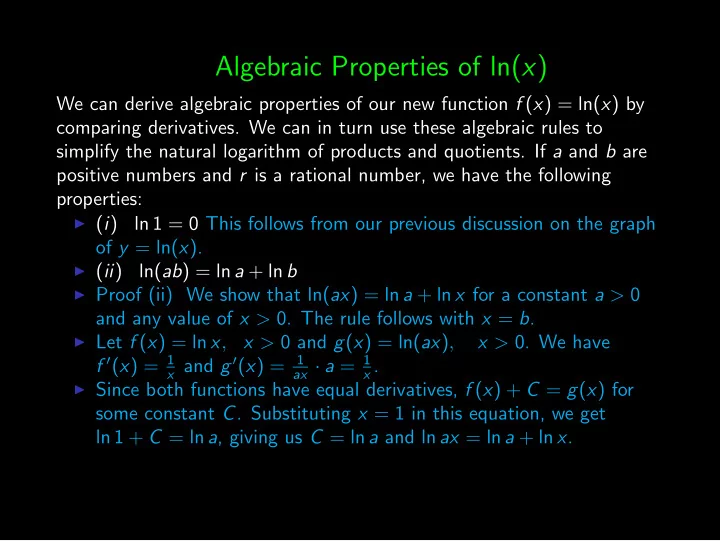

Algebraic Properties of ln( x ) We can derive algebraic properties of our new function f ( x ) = ln( x ) by comparing derivatives. We can in turn use these algebraic rules to simplify the natural logarithm of products and quotients. If a and b are positive numbers and r is a rational number, we have the following properties: ◮ ( i ) ln 1 = 0 This follows from our previous discussion on the graph of y = ln( x ). ◮ ( ii ) ln( ab ) = ln a + ln b ◮ Proof (ii) We show that ln( ax ) = ln a + ln x for a constant a > 0 and any value of x > 0. The rule follows with x = b . ◮ Let f ( x ) = ln x , x > 0 and g ( x ) = ln( ax ) , x > 0. We have f ′ ( x ) = 1 ax · a = 1 1 x and g ′ ( x ) = x . ◮ Since both functions have equal derivatives, f ( x ) + C = g ( x ) for some constant C . Substituting x = 1 in this equation, we get ln 1 + C = ln a , giving us C = ln a and ln ax = ln a + ln x .
Algebraic Properties of ln( x ) (iii) ln( a b ) = ln a − ln b a = ln( a · 1 a ) = ln a + ln 1 ◮ Note that 0 = ln 1 = ln a a , giving us that ln 1 a = − ln a . b = ln a + ln 1 ◮ Thus we get ln a b = ln a − ln b . ln a r = r ln a . ◮ (iv) ◮ Comparing derivatives, we see that d (ln x r ) = rx r − 1 = r x = d ( r ln x ) . x r dx dx Hence ln x r = r ln x + C for any x > 0 and any rational number r . ◮ Letting x = 1 we get C = 0 and the result holds.
Example 1 Expand ln x 2 √ x 2 + 1 x 3 using the rules of logarithms. ◮ We have 4 rules at our disposal: (i) ln 1 = 0, (iii) ln( a ( ii ) ln( ab ) = ln a + ln b , b ) = ln a − ln b , (iv) ln a r = r ln a . ◮ ln x 2 √ = ln ( x 2 √ x 2 + 1) − ln ( x 3 ) x 2 +1 (iii) x 3 = ln( x 2 ) + ln(( x 2 + 1) 1 / 2 ) − ln( x 3 ) (ii) ◮ 2 ln( x 2 + 1) − 3 ln( x ) (iv) = 2 ln( x ) + 1 ◮ 2 ln( x 2 + 1) − ln( x ) ◮ = 1
Example 2 Express as a single logarithm: ln x + 3 ln( x + 1) − 1 2 ln( x + 1) . ◮ We can use our four rules in reverse to write this as a single logarithm: (i) ln 1 = 0, ( ii ) ln( ab ) = ln a + ln b , (iii) ln a r = r ln a . ln( a b ) = ln a − ln b , (iv), = ln x + ln( x + 1) 3 − ln √ x + 1 (iv) ◮ ln x + 3 ln( x + 1) − 1 2 ln( x + 1) = ln( x ( x + 1) 3 ) − ln √ x + 1 (ii) ◮ = ln x ( x +1) 3 (iii) ◮ √ x +1
Example 3 � e 2 1 Evaluate t dt 1 ◮ From the definition of ln( x ), we have � e 2 e 2 1 � 1 = ln( e 2 ) t dt = ln( t ) � � 1 ◮ (iv) = 2 ln e = 2 .
Recommend
More recommend